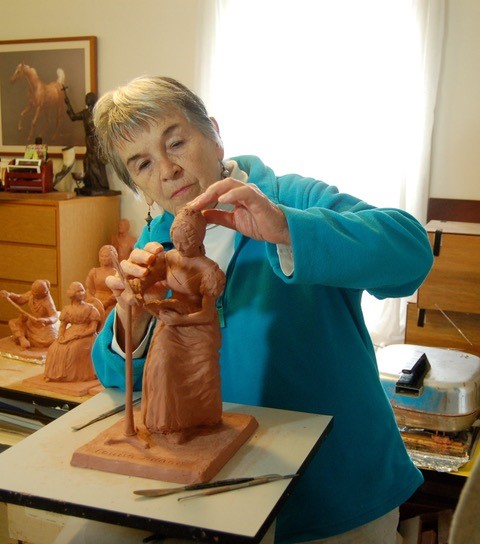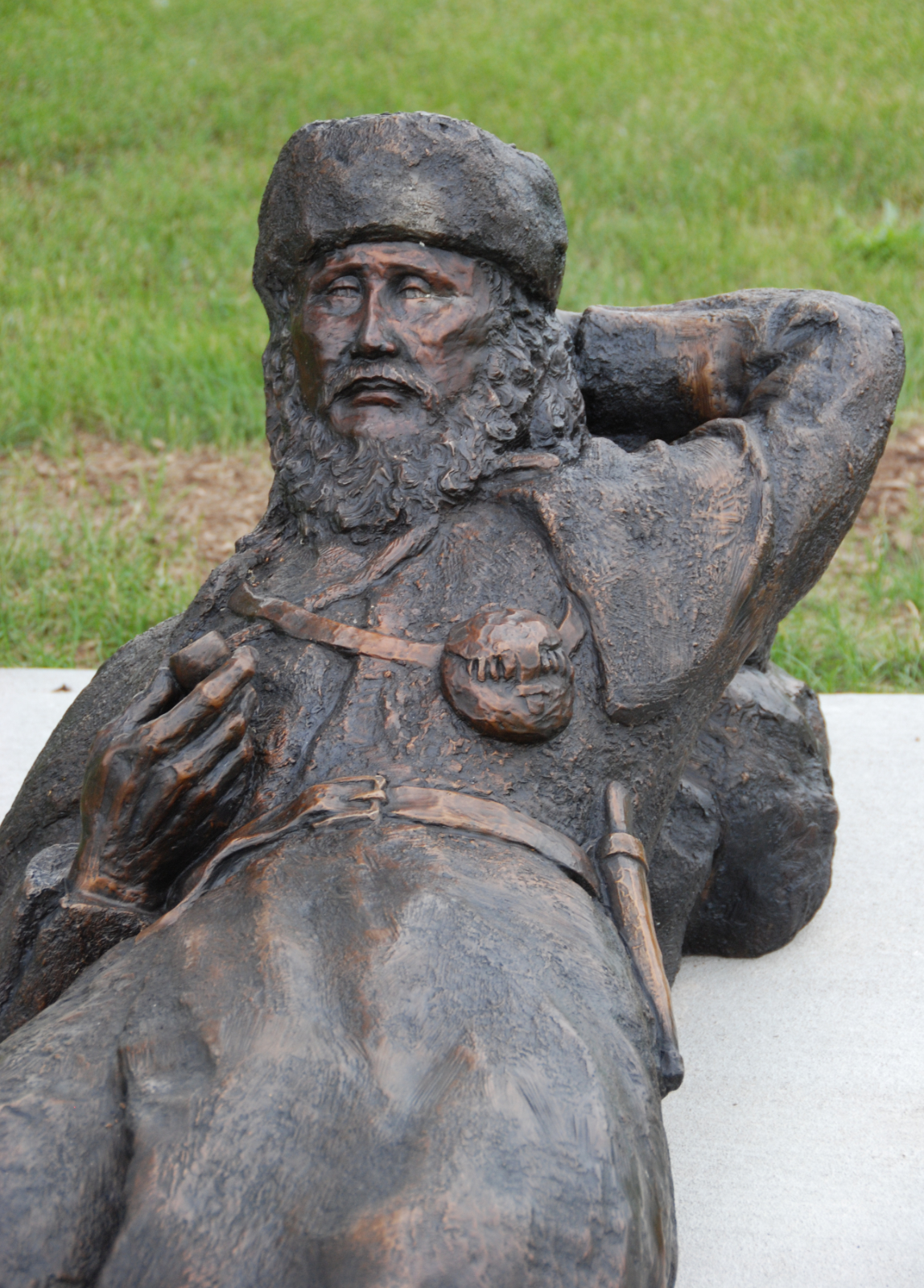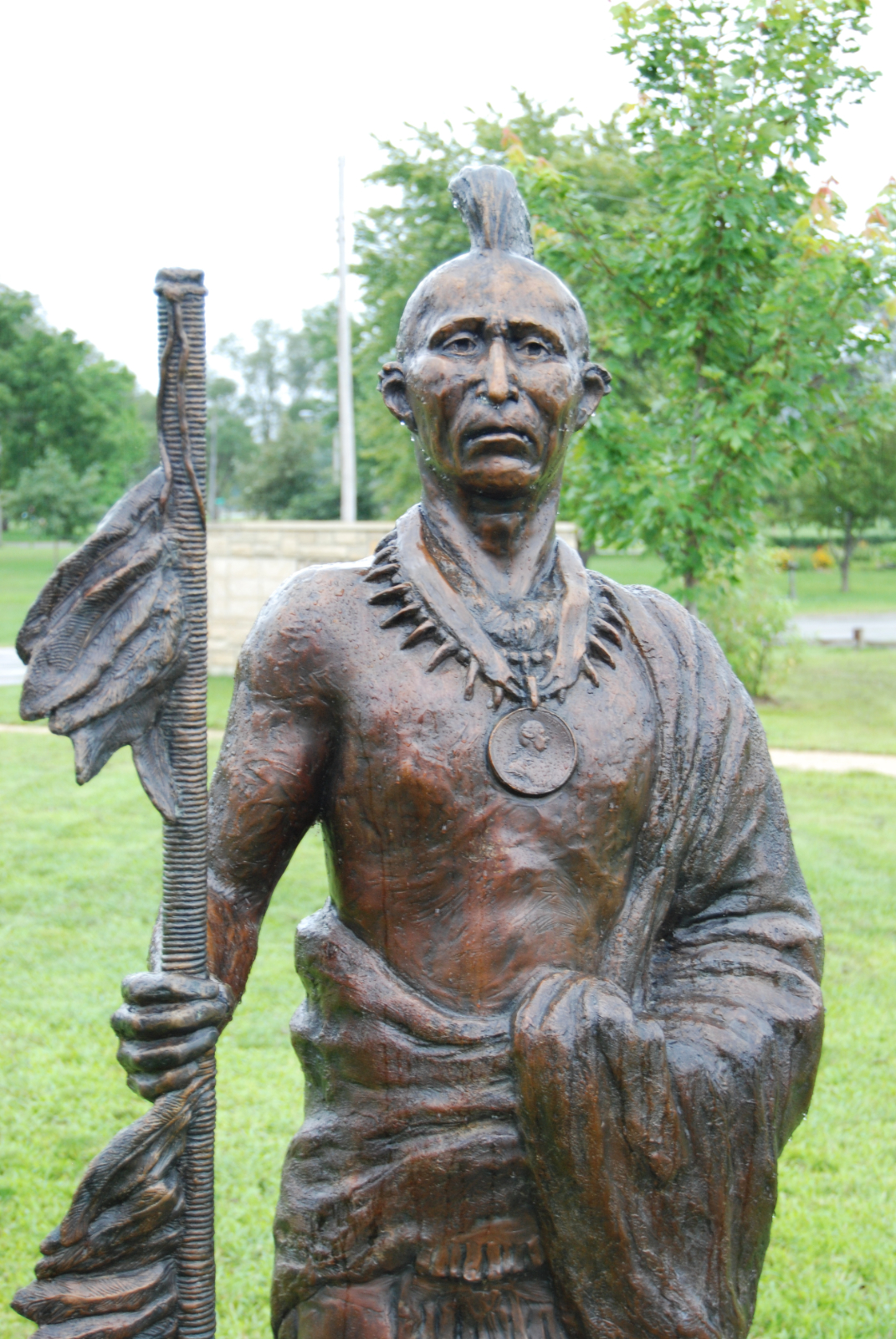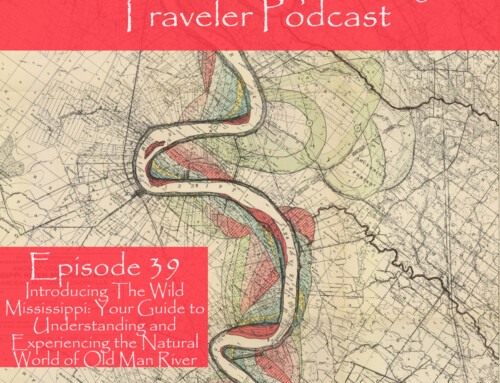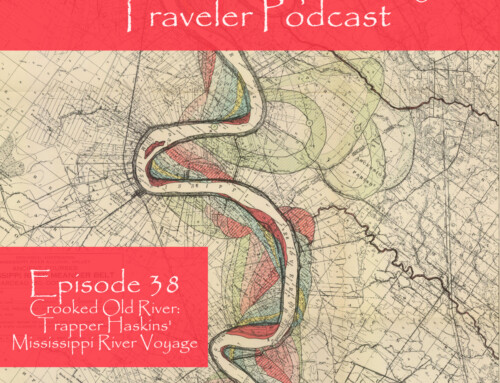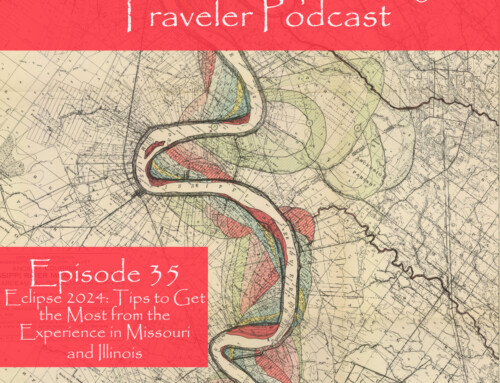The Mississippi River has inspired artists of many stripes, including Prairie du Chien-based sculptor Florence Bird. In this episode, I talk with Bird about her path into a career as a professional artist, how she found inspiration from the Mississippi, and the details of how she goes from idea to a life-sized bronze statue. Bird is enthusiastic about her art and the Mississippi and was an absolute delight to interview. I start this episode with a brief review of the history of the area that Bird finds so inspiring.
In the Mississippi Minute, it’s spring! But it’s also very early for spring, especially Up North. I describe some of the action going on and wonder what you’re seeing in your part of the river.
Show Notes
You can learn more about Florence’s work as an artist here: Florence Bird’s website
To learn more about the plans for all of the sculptures (and to find out how to donate), go here: Mississippi River Sculpture
More about Prairie du Chien’s history
Support the Show
If you are enjoying the podcast, please consider showing your support by making a one-time contribution or by supporting as a regular contributor through Patreon. Every dollar you contribute makes it possible for me to continue sharing stories about America’s Greatest River.
Don’t want to deal with Patreon? No worries. You can show some love by buying me a coffee (which I drink a lot of!). Just click on the link below.
Transcript
36. Florence Bird
Wed, Mar 13, 2024 8:17PM • 36:15
SUMMARY KEYWORDS
prairie du chien, sculptures, mississippi, river, sculpture park, mississippi river, florence, clay, prairie, wisconsin, area, moved, bronze, bronze sculptures, big, creating, podcast, art, island, image
SPEAKERS
Florence Bird, Dean Klinkenberg
Florence Bird 00:00
And I came by here and I was standing down there by the river, my feet in the Mississippi River and just wondered who stood here before me. And that started the whole idea.
Dean Klinkenberg 00:36
Welcome to the Mississippi Valley Traveler Podcast. I’m Dean Klinkenberg and I’ve been exploring the deep history and rich culture of the people in places along America’s greatest river, the Mississippi, since 2007. Join me as I go deep into the characters and places along the river and occasionally wander into other stories from the Midwest and other rivers. Read the episode show notes and get more information on the Mississippi at MississippiValleyTraveler.com. Let’s get going.
Dean Klinkenberg 01:08
Welcome to Episode 36 of the Mississippi Valley Traveler Podcast. I’m just back from a few days on the road mostly up north in the Driftless area. So I’m just a little late getting this episode out. I had a chance on this trip to catch up with sculptor Florence Bird who lives in Prairie du Chien where she’s creating a really interesting little sculpture park populated by people who left their mark on this remarkable area. Prairie du Chien is the second oldest city in Wisconsin, but the area has a long and rich history well before the Europeans were here. People have lived in this vicinity for at least 12,000 years. The prairie here provided a home and sustenance for indigenous people, including Ho-Chunk, Sauk, Meskwaki, Dakota and probably some Ojibwe people as well. The city was was built on a wide prairie next to the Mississippi, just upriver from the confluence of the Mississippi and Wisconsin rivers. As European fur traders moved into the area, they gathered on this prairie for regular trading fairs called rendezvouse. Eventually some of those folks put down roots and a small community grew. And you may also remember from a previous episode that this area is where the Marquette and Joliet expedition reached the Mississippi as they came down the Wisconsin River in 1673. The town’s name probably dates back to about the 1730s when fur traders encountered a Meskwaki camp on this prairie. There was a chief living with the Meskwaki named Alum. I’m probably butchering that name, which meant ‘dogs’. So the French traders translated that word into its French counterpart chien, hence the prairie of the dog or the prairie of the chief named dog, more likely. When Jonathan Carver passed through in 1766, he found a thriving village of about 300 families. Prairie du Chien remained an important post into the 19th century. Zebulon Pike pass through there in 1805 on his expedition up the Mississippi to find the source. British forces occupied the area during the War of 1812 with the help of their Native American allies, but this remote outpost eventually got the attention of Washington DC when the fur trade boomed. The US military built Fort Crawford after the War of 1812. And John Jacob Astor in his fur trading empire, his fur trading monopoly honestly, dominated the area until the 1840s, until about the time the fur market collapsed. In August of 1825, the US government convened a large council of Native American leaders at Prairie du Chien to demarcate land boundaries for each nation. Although later the US would just move to negotiate or take the land it wanted anyway. Among those leaders who were present were Wabasha, Red Wing, Little Crow, all of them from Dakota nations. Keokuk who was Sauk and Decari from the Ho-Chunk. One person who was noticeably absent was Black Hawk. So because of that, the Sauk people did not feel like they were fairly represented at these negotiations. Lieutenant Colonel Zachary Taylor served at Fort Crawford. He won election as 12th president of the United States in 1849. One of his lieutenants was Jefferson Davis, the future president of the Confederacy. Davis developed a crush on Taylor’s daughter Sarah Knox Taylor, but Zachary didn’t approve. He didn’t want his daughter marrying a military man. Davis resigned from the army to marry Sarah anyway, and they both soon contracted malaria when they were down visiting Davis’s sister in Louisiana. Jefferson survived but Sarah did not. They had only been married for three months when she passed away. As the fur trade waned Prairie du Chien became an important port for shipping wheat and lumber and attracted new residents. The Milwaukee and Mississippi railroad arrived in 1857, which completed the first rail line across Wisconsin. The new jobs from the railroad attracted a lot of Irish immigrants, who were then followed by waves of Bohemians and Germans who moved into Prairie Du Chien. The more established French families turned to farming mostly on land in the northern part of town. Around this time, John Lawler was running a ferry across the Mississippi and then he helped drive construction of a very innovative pontoon bridge for railroad trains across the Mississippi. After the big flood of 1965, and several smaller ones in subsequent years, the Army Corps of Engineers used Prairie du Chien as a test case for its first flood protection program that did not involve building taller levees. Under this approach, the Corps purchased property in flood prone areas and move residents to higher ground. Between 1978 to 1984, 121 properties were purchased and its residents relocated. Some people took their homes with them, in one case an entire block of six houses was moved together. Prairie du Chien has lost much of its old town to that unruly mistress the Mississippi. The location of the original town is now Saint Feriole Island, and it’s mostly a park. But it continues to reshape itself as it moves forward into its fourth century. This is just kind of a quick overview of the history of the area. And you can give you a sense of what some of the history was that Florence Bird found so compelling when she came up with this idea to do this sculptures. You can read more about Prairie du Chien’s history on my website, and I’ll post a link to that post in the show notes.
Dean Klinkenberg 06:50
So in this interview, Florence and I talked about how she got her start as an artist, her early interest in art. A little bit about the inspiration she had for creating these sculptures, and some detailed description of how each bronze statue is constructed. One quick note, Florence Bird relies on donations to get the sculptures finished. So if you’re you’d like to contribute again, go to the show notes. I will have a link to her website, where you can find out how you can make a check and maybe sponsor one of those sculptures yourself.
Dean Klinkenberg 07:30
As always, thanks to all of you who are supporting this podcast through Patreon. Thank you, thank you, thank you, you keep this podcast alive. If that’s not your thing, hey, you buy me a coffee, drink plenty of that. If you want to know how to do that, just go to my website, MississippiValleyTraveler.com/podcast and you’ll find instructions there on how you can buy me a coffee. For shownotes, same place, go to MississippiValleyTraveler.com/podcast. And now let’s get on to the interview.
Dean Klinkenberg 08:13
Florence Bird is a Prairie du Chien based artist and sculptor. She specializes in creating life size bronze statues cast from original works. She creates first in maquette and ultimately in bronze cast of sizes ranging from tabletop works through life size and larger than life pieces. She’s best known for her work as the resident sculptor for the Mississippi River Sculpture Park located on St. Feriole Island in Prairie du Chien, Wisconsin which is where we are today. Welcome to the podcast Florence.
Florence Bird 08:42
Thank you very much. I’m glad to meet you and happy to be here.
Dean Klinkenberg 08:48
It’s a real treat to talk to you in person, we’ve had a chance to talk on the phone a couple of times and I really appreciated that and I thought as long as I was in the area, it’d be fun to be able to talk to you in person and to be here with your sculptures. Unfortunately, it’s a little too cold and windy to be out there walking around the as we record this today, but so we’re just going to chat a little bit about your background and your work and then we’ll talk some about those pieces. So tell me a little bit about your path to becoming an artist. How did you get started?
Florence Bird 09:20
Oh, I started when I was five years old. Somebody gave me art lessons.
Dean Klinkenberg 09:26
What do you remember what you did at five years old?
Florence Bird 09:30
Yeah, I did. A beautiful big maple tree. I remember my best friends were twins and their mother was an artist and she used to babysit us and take us out sketching and that’s how I first started making art.
Dean Klinkenberg 09:51
So did you know from that early age, that you really wanted to do that kind of for your as a living or as an adult?
Florence Bird 09:59
No, I was just having fun. And I didn’t know till many, many, many more years that I was going to be a professional artist. I just that’s what I always wanted to do. So that’s, it’s more more fun than anything else I can think of so.
Dean Klinkenberg 10:23
So how did you begin your career as a professional artist and what what did you do to get that going?
Florence Bird 10:29
Oh, I went to college and I have a Master’s Degree in Art. And I always, I dreamt about doing life size bronze sculpture, because that’s just the height of the you know, doing sculpture. And I had no idea that I would, many, many years later, have this wonderful project, this idea for this wonderful project here in Prairie du Chien.
Dean Klinkenberg 11:04
So what was the first piece you sculpted?
Florence Bird 11:07
Here?
Dean Klinkenberg 11:09
The first piece in your, in your professional career? What was the first piece of sculpture you created?
Florence Bird 11:14
Oh, my goodness sakes, I there was, there is in Roseville, California, there is a big outdoor sculpture I created along with another artist, Tommy Moller. And we did an outdoor sculpture of the Maidu family, which is a Native American family in Roseville, California. And that’s, that’s, I would say that’s the main beginnings. Yes.
Dean Klinkenberg 11:52
I will get to the sculpture park here in Prairie du Chien in just a couple of minutes. But you had a long career before you even began starting these sculptures here. So tell me a little bit then about your what you were doing professionally before you came up with the idea for these sculptures.
Florence Bird 12:08
I was teaching. I was just because sort of a family tradition. My father was a teacher and so on. So I was teaching Art. And then I just came to came back to Wisconsin. I was in California for many, many years. And I came back to Wisconsin, because this is my family roots, Wisconsin is my family roots. Spring Green, Wisconsin. And so I was just I was couldn’t find a teaching job. I didn’t know what I was gonna do. And then I finally thought, well, you have nothing to lose. So why not go for what you really want to do. And that is to do life size bronze sculptures. And that’s what, what started the idea. And then I couldn’t help myself. Somebody gave me money for clay. And I started making little clay maqutte models of what I thought would be wonderful here. And then as I visited Prairie du Chien, I didn’t know it existed, I was going somewhere else and I came by here and I was standing down there by the river, my feet in the Mississippi River and just wondered who stood here before me. And that started the whole idea. So I went to the information, the Prairie du Chien Chamber of Commerce information, and she started telling me some of the stories on St. Feriole Island. It was the major historical spot because it’s where are the treaties with the Native Americans were signed in 1825 and 1828. So that started me off.
Dean Klinkenberg 14:24
It’s amazing how a single relatively simple thought can lead you down this path to creating such a big project.
Florence Bird 14:34
Oh, well. I’ve been doing it for 20 years. I love it. It’s just what I always wanted to do. And it’s just as interesting to me now, as it was in the beginning. And each new sculpture. Each one has a story a little personal story about it. That led, I can give you a for instance, Dr. Beaumont, we can see him from here and as a little boy, he was a family man. And he wore a toupee. We joked at the foundry about or removable toupee. But anyway, he treated this, his patient had a wound in his stomach. A bullet wound and it had healed but it hadn’t closed. And so he was able to take food, put it on a string and feed it into his digestive system. And find out what was happening that we had a lot of fun when we were teaching the children about it.
Dean Klinkenberg 15:52
I bet they loved that.
Florence Bird 15:55
So that’s one little story. There’s stories for each sculpture.
Dean Klinkenberg 16:00
So does Dr. Beaumont statue have a string with little food attached to it?
Florence Bird 16:08
No. No, let’s see. He has he was a family man. So he is he’s pictured with his little boy holding a frog, you know, just because he was a family man.
Dean Klinkenberg 16:24
So you came up with this idea and I believe you have outlined plans for as many as 26 sculptures. Is that correct?
Florence Bird 16:34
Yes, yes.
Dean Klinkenberg 16:36
And how did you sort through all that history in this area, then how did you sort through all that and settle on those 26 sculptures?
Florence Bird 16:46
Oh, I just had so much information people, local people would come up to me and tell me stories about the history of Prairie du Chien and, and it’s just and then. Oh, my gosh, there’s, you can see on our website, there was a timeline. There’s people that have Mastodon bones. I mean, there’s this into ancient history. There were people here and evidence right here on St. Feriole Island. So it’s kind of a non ending history.
Dean Klinkenberg 17:28
So at the current and right now, there are six sculptures that are out there. So tell us who are the six sculptures?
Florence Bird 17:35
Oh, okay, there’s Dr. Beaumont. There’s Chief Black Hawk. And there’s Emma Big Bear. And the Voyager. Who did I miss? Oh, Aunt Marianne LaBuche. And oh, each one has wonderful stories. Aunt Marianne LaBuche was a doctor here before there were doctors. And she had rescued who turned out to be a grandchild when there was an uprising, Winnebago uprising here. And she had she had 13 children and her grand daughter had 13 children. So when we unveil Aunt Marianne LaBuche, we had a lot of family members here.
Dean Klinkenberg 18:37
Wow. That can be a big family reunion. So when you create a sculpture, you’re you have to have a particular image of that individual. So how do you just you have a whole lifetime worth of possibilities to choose from for somebody. So for let’s just take somebody a little more contemporary, like Emma Big Bear, how did you decide what image to base your sculpture on?
Florence Bird 19:09
Oh, there are many images of Emma Big Bear. She lived to be 99 years old, and friends of mine remember her sitting in the park, making her baskets. And so there are many there are photographs of her and postcards of her lots and lots of images. And she it was wonderful when we unveiled her because the Winnebago, the Ho-Chunk, came down and did a drumming for the occasion. And it was quite wonderful.
Dean Klinkenberg 19:50
So I guess when I met you, you had a lot of different possibilities for how you wanted to, how you could represent Emma Big Bear, and all these pictures so what image popped in your head that you were gonna use them for the sculpture?
Florence Bird 20:01
Oh my goodness, I’m trying to remember. Um, I think just to her sitting there making her baskets and that was that and, and there was an image of her bandolier I was able to copy that image. And just that that struck me as a wonderful thing that would be just to see that see her sitting there making her baskets.
Dean Klinkenberg 20:34
It seemed like a very iconic way to portray her. That’s the way a lot of people remembered her probably right?
Florence Bird 20:40
Yes, I believe so.
Dean Klinkenberg 20:43
And for the Voyager, the Voyager is kind of reclining on the ground. Right? Why did you choose that particular style for representation for the Voyager?
Florence Bird 20:54
Well, the voyagers moved up and down the rivers, collecting beaver pelts and so on. And he’s resting on his beaver pelts. And every so often, I forgot how often they would stop for what they called a pose’ and it was to smoke their pipes. And then they would continue on traveling. So I have him resting. Like he was pausing. And I have him pictured with his pipe and his tobacco pouch and resting on his beaver skins.
Dean Klinkenberg 21:37
That’s fantastic. He looks like he’s he’s pretty chill relaxed, having a nice time there relaxing, very different than if he was in a canoe and paddling hard away or carrying 100 pounds or more gear across of portage?
Florence Bird 21:51
Absolutely.
Dean Klinkenberg 21:54
I was curious, you know, when we were talking about the inspiration for these different sculptures. For Black Hawk in particular, I know I’ve seen paintings of him that look very different from each other. So how did you settle on what image to use for him?
Florence Bird 22:09
Well, I found out I don’t remember how I found out down on Rock Island, there’s a museum for him. And in the museum, there is an impression from his death mask. And I was able to take a picture of that. And, and, and I still have the picture on my computer. So that’s what that’s what gave me the impression of his face. It’s from his actual death mask.
Dean Klinkenberg 22:42
Well, so from that, did you sketch an image? Or how did you translate that into the sculpture?
Florence Bird 22:49
Well, I just go directly into the clay.
Dean Klinkenberg 22:52
No, no need for an intermediate step. You just go right to the clay.
Dean Klinkenberg 23:01
Hey, Dean Klinkenberg here interrupting myself. Just wanted to remind you that if you’d like to know more about the Mississippi River, check out my books. I write the Mississippi Valley Traveler Guide Books for people who want to get to know the river better. I also write the Frank Dodge mystery series set in certain places along the Mississippi. Read those books to find out how many different ways my protagonist Frank Dodge can get into trouble. My newest book, “Mississippi River Mayhem” details some of the disasters and tragedies that happened along Old Man River. Find any of them wherever books are sold.
Dean Klinkenberg 23:37
So you have the six of them here now. Is there another one that’s on the verge of being unveiled? Are you close to being able to produce another one?
Florence Bird 23:48
They have funds, some funds collected for John Lawler. John Lawler was more…people around here would know who he was. He was responsible for Campion Jesuit boy’s school. He was also responsible for hiring an engineer for building a railroad crossing of the Mississippi River. Which if you think about a railroad connecting both Wisconsin and Iowa, on the Mississippi and a drawbridge at that for the boats to go through. So that’s mainly what it was famous for here.
Dean Klinkenberg 24:33
All right, so that one is probably going to be the next one.
Florence Bird 24:37
And then Marquette and Joliet, of course “discovered” the Mississippi River by coming down the Wisconsin River here and that’s there’s people remember hearing about them from grade school. So that would be the natural next one.
Dean Klinkenberg 25:07
Right and we just marked the 350th anniversary of their canoe trip down the river. So take me through the process of creating one of these sculptures and what are the steps involved for you to go from the idea stage to the final bronze sculptures that we see in the park?
Florence Bird 25:27
Okay, what I do is I start with some wire, sculpture wire and, and pack some clay around it. And because my training is in sculpture, I really love doing the the original clay maquettes because I can get the gesture and so on in them. And so once the maquettes, the models, are done, then they go to the foundry which our foundry is an art services in Milwaukee actually. And they will take a mold and do send it off for enlarging. There are different enlarging companies, one’s in California and one’s in Minneapolis. And they will enlarge it and put it in foam Styrofoam. And then I would get it back in the studio. They a large Styrofoam one. And I have a whole lot of clay. And I melt that sort of warm it in a in a pan. And so I apply clay all over it. And then I’m able to really get the details and expressions on the person’s face.
Dean Klinkenberg 26:54
All right, and that so then you have a clay, a good clay model at that point?
Florence Bird 26:59
Of the of the big one.
Dean Klinkenberg 27:01
Alright, so this is the life size.
Florence Bird 27:05
And then it goes back to the foundry. And they do piece molds from all over it. And in each piece mold they take a wax impression that’s about three quarters of an inch thick. And they take from those piece molds, they take the wax impressions, and encase them in plaster like material mold material. And that goes in a kiln and the wax melts away. In the meantime, they’ve been heating the bronze to about 2100 degrees. And so when when the mold comes out of the kiln, then they’re able to pour the bronze in where the wax used to be. And then of course, there’s all the welding it back together and finishing it and you know, polishing it and then shipping it, installing it here. So
Dean Klinkenberg 28:09
So from the time when you send them the model for the final bronze casting until you get it back. How long does that process take?
Florence Bird 28:18
We count six or eight months?
Dean Klinkenberg 28:21
Wow, yeah, it’s yeah, that’s takes quite a while.
Florence Bird 28:24
It’s a lot of long process and they hire a lot of people to do this. So I mean, it may come a little sooner, but then it has to be shipped and then installed on a concrete pad here and on all of that so.
Dean Klinkenberg 28:43
So one thing I was curious about then too is what do you how do you hope people will experience these when somebody comes here to visit the sculpture garden. How would you hope they approach visiting the site?
Florence Bird 29:00
Oh, I hope that they’re like children that go up and touch them, take pictures of themselves with it, just whatever they like to do. Bronze sculptures will be here 1000s of years, so it’s pretty hard to damage them. I guess you could take a torch and melt it but nobody has yet.
Dean Klinkenberg 29:30
And each of them has a plaque with a little background information or biography of each person.
Florence Bird 29:35
Well the person who donated the money for it, and the name of the sculpture and the foundry name. So my name I think is somewhere on there.
Dean Klinkenberg 29:49
Well, I would hope. So you’ve also in terms of like where things are right now. I think you told me before that you already have like small tabletop size bronze castings for all 26.
Florence Bird 30:03
No, just the clay, just the clay maquettes.
Dean Klinkenberg 30:07
All right.
Florence Bird 30:08
I have a few of them. There’s a couple in cold cast bronze, nobody’s doing the cold cast bronze anymore, cold cast bronze is actually plaster plastic with bronze powder in it. And nobody’s doing those anymore. So I have a couple of those. And I have a couple of small maquette size bronzes, which I had done.
Dean Klinkenberg 30:36
You know, one thing I was thinking about I forgot to ask. Sculpture is your main medium, but do you do other kinds of art too? Do you paint or draw?
Florence Bird 30:45
Oh yeah, I have lots and lots of paintings in storage. Lots and lots of drawings. And I’ve just done art all of my life. And I won’t tell you how long that’s been.
Dean Klinkenberg 30:55
And I remember reading. I think one of the websites that I looked over, that you feel is especially inspired by the natural world and by waterways. Can you say something about how that informs your art?
Florence Bird 31:12
That’s my paintings, you know, the Wisconsin River at Spring Green, I have many, many memories and many photographs from the Wisconsin River. And so a lot of my paintings are inspired by that. And then I got to come over here and Prairie to Chien, and went to Pike’s Peak and, and in Iowa and there’s just so many opportunities for photograph for scenic ones. I just, I just love the scenes, the river scenes and the forest scenes. That’s what my paintings are about.
Dean Klinkenberg 31:56
Well, try to think. Is there anything else I missed about this process? Anything else you want to add to?
Florence Bird 32:03
I probably will think of it when I get back home. I’ll email you.
Dean Klinkenberg 32:10
So if, if people are interested in seeing more about your work, or maybe even images of some of the future bronze statues you’d like to create, where would they go to find that?
Florence Bird 32:23
FlorenceBird.com or the Mississippi River Sculpture Park. That’s on Google so you can Mississippi River Sculpture Park will tell you more about the sculpture park. If you want to learn more about me it’s FlorenceBird.com.
Dean Klinkenberg 32:42
Great. So the Mississippi River Sculpture Park is on Feriole Island in Parade du Chien. Is the sculpture park itself now owned by the community or like who manages that?
Florence Bird 32:55
It’s managed by the Prairie du Chien Parks Department. It’s one of the parks in Prairie du Chien. And the present director is Mike Wallace. And he grew up with the sculpture park. He’s a native person here. So he’s very supportive.
Dean Klinkenberg 33:18
Fantastic, Florence, thank you so much for the time and for this, you know, a creative way of being able to chat and record an interview. Thanks so much for your time.
Florence Bird 33:27
Thank you for being here.
Dean Klinkenberg 33:44
And now it’s time for the Mississippi Minute. I am just back from a few days on the road to do some research to update my “Road Tripping the Great River Road” guide book. Should have a new edition out by early May. It, boy it has been such an unusual winter unusually warm, it was so obvious driving up the Great River Road the last few days. There’s no snowpack. They haven’t had much snow in general. And because of that the river is still pretty low up north. There’s some back channels that are dry or nearly dry, much less water than I’ve seen for a long time. On the other hand, there are a lot of birds migrating through already. Just from my car I can see tundra swans, pelicans, saw a couple of trumpeter swans, lots and lots of ducks, flocks of red wing blackbirds making their way north. Just just an incredible scene in terms of the number of birds. I don’t know how this year is gonna play out. Hopefully we’ll get a bunch of rain this spring and the river will come back up. But I was really struck by how early everything was coming to life. This is not normally the way things go up north. I’m curious to what the river is like where you are. What are you seeing because of this unusually warm winter and this early start to spring? Drop me a note at MississippiValleyTraveler.com/contact
Dean Klinkenberg 35:15
Thanks for listening. If you enjoyed this episode, subscribe to the series on your favorite podcast app so you don’t miss out on future episodes. I offer the podcast for free but when you support the show with a few bucks through Patreon, you helped keep the program going. Just go to patreon.com/deanklinkenberg. If you want to know more about the Mississippi River, check out my books. I write the Mississippi Valley Traveler guide books for people who want to get to know the Mississippi better. I also write the Frank Dodge mystery series set at certain places along the river. Find them wherever books are sold. The Mississippi Valley traveler podcast is written and produced by me Dean Klinkenberg. Original Music by Noah Fence. See you next time.
